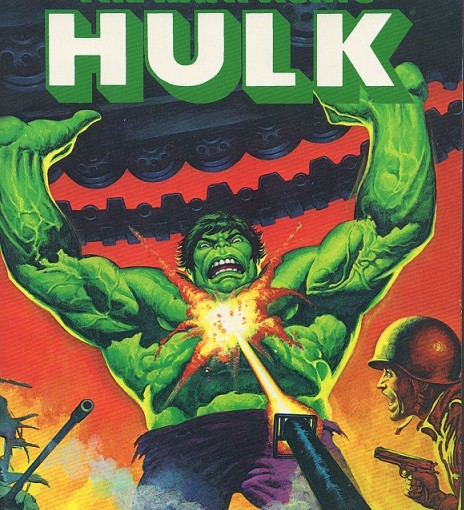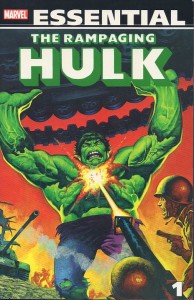Comic Book Review: Essential Rampaging Hulk, Vol. 1 story by Doug Moench, art by various.
Doctor Bruce Banner was one of the nation’s top physicists, and an expert in gamma radiation, when he was drafted into creating a new kind of nuclear weapon called a “gamma bomb.” Just before the device was about to go off, Dr. Banner saw a young man (soon to be known as Rick Jones) driving into the danger area. Ordering the test delayed, Banner went out to save the boy. But a Communist agent prevented the order from being received in hopes of killing Banner and crippling America’s bomb research.
Rick Jones was tossed to safety, but Dr. Banner was struck by a massive dose of gamma radiation, which had a bizarre effect. Under certain circumstances (initially nightfall, later anger) Banner would turn into a monstrous green creature of destruction that was codenamed the Hulk. General Thaddeus “Thunderbolt” Ross became the Hulk’s mortal enemy, not realizing that the monster was also the romantic interest of his daughter Betty.
Bruce Banner had to evade having his secret revealed, while the Hulk battled the army and various supervillains. And that was the premise of the six-issue The Incredible Hulk series. Sales weren’t that hot, and the Hulk was rotated out for other features, not having a solo outing again until Tales to Astonish put him in the same magazine as Namor.
In 1977, Marvel Comics had started producing black and white magzines as well as their regular comic books. These were primarily aimed at slightly older readers as they evaded the Comics Code, and were sold in stores that no longer bothered with a comics rack. The Rampaging Hulk was a bit of an exception. It was retroactive continuity, revealing what Banner and Jones had been up to during the period in the early 1960s they weren’t being published.
These longer tales involved the Hulk battling the menace of the Krylorians, an alien race bent on conquering the Earth. He was aided by Rick Jones and a renegade Krylorian artist named Bereet. The Krylorians were somewhat comical–they could disguise themselves as humans like the Skrull, but often weren’t very good at it. They were also a squabbling, backbiting lot who barely cooperated at times. The X-Men, Namor the Sub-Mariner, and a pre-Avengers assemblage of the Avengers made guest appearances.
That storyline ended in issue 9. With the success of the Hulk TV series starring Bill Bixby and Lou Ferrigno, it was decided to make the magazine a tie-in of sorts to that. The name was changed to The Hulk! though the numbering was kept for tax reasons, the setting was moved to the current day, and the series was now in color. The stories focused on Bruce Banner as a wanderer who kept running into problems no matter where he went, and invariably wound up Hulking out. The stories involved such contemporary issues as terrorism and child abuse (one of these stories is apparently the first one to suggest that Bruce Banner was abused as a child, which was later used to explain some of his issues.)
Hulk’s usual supporting cast was absent, although there was a brief crossover with back-up feature Moon Knight.
There were a variety of artists, from Walt Simonson to Bill Sienkiewicz (in his Neal Adams homage period). One issue has a fill-in story by Jim Starlin that is kind of trippy. The character of the Hulk wasn’t really a good fit for Doug Moench, but his writing is serviceable throughout. The switch to color in later issues is lost in this reprint, which makes the art muddy in places.
This volume collects up to issue #15. There are a few pages from Incredible Hulk #269, a story by Bill Mantlo that brought Bereet into the present day by revealing that the events in The Rampaging Hulk #1-9 were in fact her alien fanfilms, with her as a self-insert character. This did explain a lot of the continuity glitches and a couple of other questions, but some readers felt it was a cheat.
This volume is primarily for die-hard Hulk fans; others will want to check their local libraries.
And now, some sad music.



Right – that theme music always did (and still does) create a bit of a pang in my heart. Thanks for the retrospective – not only relative to a show I actually tuned into but also the comic books beginnings of this character. Learn something new everyday. Had no idea this started as a Soviet curse.
Early 60s Marvel relied heavily on Communists and psuedo-Communists as villains. Iron Man especially tended to fight the Red Menace.
What a curious unfolding. I always marvel (snort!) at what creative lengths comic story lines go to explain back stories and make connections. I always wonder if our history book writers must have comic writing in their backgrounds.
It’s a similar sort of reasoning, called “narrative causality”. Historians try to piece together a coherent story that fits the known facts and makes sense to them and other historians, and by extension the public.
I was a so so fan of The Incredible Hulk as I didn’t “get” that he turned green when he was angry. Thanks for filling in the blank spot Scott. It makes so much more sense. And your St. Patrick’s Day greenery is very timely. Loved the music addition at the end too.
In the very first issue, Hulk was actually supposed to be grey. But the poor color separation process of the time wound up with him in four or five different hues, including emerald green. Stan Lee liked that look, so that became the Hulk’s official color.
Who could forget the hunky Bruce Banner…..he was a dreamboat for sure. I always wondered how the green color of the hulk would disappear as he turned back into Bruce. But then leave it to the marvels of the comic book industry to spark the imagination.
There have been a few technobabble explanations of the color change over the years, but like Namor’s tiny wings, it’s usually best not to think about it very hard.
Wow….I loved that show and now I know “the rest of the story” how awesome is that! Thanks!
You’re welcome!